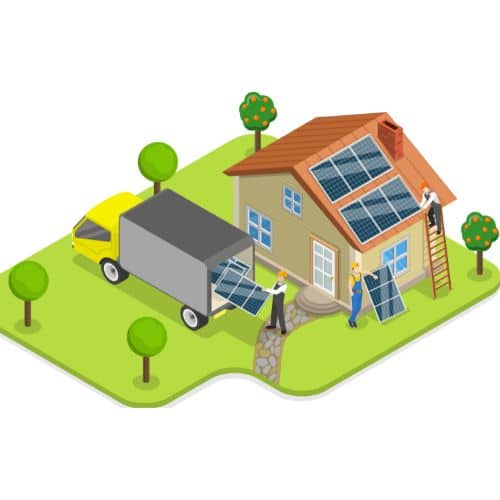
In this page
Generating income from a farm can be tough. For those on the land, the 21st century has brought additional challenges in maintaining traditional farming revenue streams – yet costs keep rising, particularly electricity.
Incorporating solar power on your farm has none of the labour-intensive nature and ongoing overheads of other aspects of farming.
No water is needed, no herbicides or pesticides, no vet bills, early morning starts or late night paddock checks. There are only benefits in providing your farm with clean, renewable power.
There’s next to no maintenance involved – the sun does all the hard work for you, saving you money while leaving you free to do other things.
What are solar farms in Australia?
There is a new type of farm that doesn’t require the manual effort of traditional farming. That is the solar farm.
Large parcels of land with connected photovoltaic power systems or solar panels extend across several acres. It is sometimes referred to as a photovoltaic power station, solar park, solar field, large-scale solar (LSS) or solar power plant. Solar farms are used to generate large amounts of solar energy simultaneously.
In contrast to small-scale solar panels, which are often used to power a single home or building, solar farms, or solar fields are designed for the large-scale production of solar energy that feeds directly into the grid-connected system.
How large is a solar farm? How big is a 1 MW solar farm?
Although there is no strict limit on capacity, ground-mounted solar farms typically start at roughly 500 kW (1 MW = 1,000 kW). However, installations more prominent than 5 MW are still significant occurrences in Australia.
Generally, a 1MW solar farm will typically occupy 2-3 hectares of land.
One of Australia’s largest-ever solar farm construction is the $30 billion project driven by Sun Cable, and it is situated in Tennant Creek, the centre of the Northern Territory.
 Image: Sun Cable – Tennant Creek, NT
Image: Sun Cable – Tennant Creek, NT
Types of solar farms
Solar farms come in various sizes and configurations, each suited to different needs. Here’s a breakdown of two prominent types:
Utility-scale solar power
Large solar farms typically cover hundreds or even thousands of acres. They generate massive amounts of electricity fed directly into the power grid, supplying clean energy to homes and businesses across a wide region. Utility-scale solar farms are a significant contributor to Australia’s growing renewable energy sector, and investment in these projects is on the rise due to their efficiency and cost-effectiveness.
Community solar farms
Community solar farms are smaller than utility-scale projects and offer an alternative for those needing more suitable rooftop space for their own solar panels. Residents can share the cost and benefits of solar energy production by subscribing to a community solar farm. This is a particularly attractive option for renters or those in areas with limited rooftop solar installations. While the profit per acre for community solar farms might be lower than utility-scale due to their size, they can still provide a good return on investment and promote community participation in renewable energy.
Benefits of solar farms
Solar farms offer a multitude of advantages, both environmental and financial. Here are the benefits of investing in solar farms in Australia.
The financial benefits of a solar farm
A solar farm receives a great return on investment, particularly considering the low maintenance involved, electricity bill savings, and the reassurance of guaranteed income in some instances!
Additionally, components in a grid-connected solar farm have no moving parts, and the solar panels have an output guarantee of 25 years.
Solar farm return on investment
By installing solar equipment on your farm, you’ll also considerably boost the value of your property!
If your solar farm in Australia is accredited as a power station, you can generate Large-scale Generation Certificates (LGCs). These LGCs can then be sold on the open market. These certificates represent the renewable energy the solar farm generates and can be sold to electricity retailers to help them meet their renewable energy targets. The sale of LRECs provides an additional revenue stream for solar farm owners, further enhancing the financial returns of solar farm investment.
Learn more about farming the sun to save on electricity – contact our friendly team with this quote request for further details.
The environmental benefits of becoming a solar farm
But the question is, are solar farms bad for the environment? Many people are concerned that chemical leaks from solar farms or installing solar farm panels is hazardous for the environment, yet neither of these claims is accurate. Aluminium, glass, and sand are the main components of solar panels, and their production is often clean.
How does large-scale solar technology work in Australia?
Large-scale solar farms use photovoltaic (PV) technology to convert sunlight directly into electricity. PV cells are made of semiconductor materials, such as silicon, that absorb sunlight and release electrons. These electrons flow through a circuit, generating an electric current.
The process of generating electricity from sunlight using large-scale solar technology in Australia can be summarised in the following steps:
- Sunlight strikes PV cells: The sun’s energy is absorbed by the PV cells in the solar panels.
- Electrons are released: The absorbed energy causes electrons to be released from the semiconductor material in the PV cells.
- Electrons flow through a circuit: The electrons flow through a circuit, creating an electric current.
- Direct current (DC) electricity is generated: The flow of electrons generates direct current (DC) electricity.
- Inverter converts DC to AC: An inverter converts the DC electricity into alternating current (AC) electricity used in homes and businesses.
- Electricity is fed into the grid: The AC electricity is then fed into the electricity grid, where it can be distributed to homes and businesses.
Embrace the energy efficiency revolution by upgrading your solar systems and adding a battery or solar inverters with Energy Matters.
Energy Matters recommends cost-effective solar batteries such as GoodWe, Enphase, sonnen, Fronius, Fimer, Sungrow, Tesla, Sigenergy and LAVO.
With our 3 free solar quotes, you can compare plans from pre-qualified and vetted installers in your area and find the perfect solution for your home and business. Harness the sun’s power and save money on electricity bills while reducing environmental impact. Let Energy Matters guide you towards a brighter, more sustainable future.
How to start a solar farm in Australia?
A geotechnical analysis must be done before a solar installation can proceed to determine which solar mounting structure may be utilised and whether the solar PV system is covered by warranty.
The following land is ideal for a solar farm:
- Up to a 5 degree flat or gently sloping incline to the south
- Suitable ground (not too soft requiring concrete foundation, not too hard requiring pre-drilling)
- The electricity infrastructure is nearby (avoiding costly trenching and cabling)
- Above a 100-year floodplain level when at full-tilt
- If a large solar farm installation (above 100kW) – then not directly visible to nearby residences
- Free of shade from nearby trees
If you’re looking for new ways to reduce operational costs, the rooftops of your sheds and farm buildings may be an important part of the answer.
The other element you need is a solar panel farm system!

Why choose Energy Matters?
- We’ve been in the solar industry since 2005 and have helped over 40,000 Australian households journey to energy independence.
- We’ve pre-qualified and vetted our solar installers accredited for their track record of delivering Australia’s best business and household solar systems.
- We’ll match you with installers who are local to you, so you can get a quote that’s tailored to your needs.
- We’re passionate about helping businesses transition to clean energy sources. By choosing solar, you’re making a positive impact on the environment.
Ready to harness the sun’s power and reduce your reliance on traditional energy sources? Contact Energy Matters today for 3 free solar quotes for your solar farm project. We have a trusted network of local, pre-qualified and vetted installers ready to provide competitive quotes to design a custom solar solution that meets your needs and budget.

What are the largest solar farms?
The largest solar farms in the world are constantly changing as new projects are completed, and older ones are expanded. However, as of today, the top largest solar farms in the world are:
Largest solar farms in Australia
Western Downs Green Power Hub: Located in Queensland, this 400-megawatt (MW) solar farm is the largest in Australia. It has over a million solar panels and can power the equivalent of 235,000 homes.
New England Solar Farm: This 720-MW solar farm is under construction in New South Wales. It will be the largest solar farm in Australia when it is completed in 2023. The farm will have a 400-MWh battery energy storage system to store solar energy at night or during cloudy days.
Limondale Solar Farm: Located in Victoria, this 350-MW solar farm is the third-largest in Australia. It has over 800,000 solar panels and can power the equivalent of 160,000 homes.
Largest solar farms in the world
Golmud Solar Park, China: With an installed capacity of 2.8 GW, the Golmud Solar Park is the largest solar farm in the world. It is located in the Qinghai Province of China and covers an area of over 40 square kilometres.
Bhadla Solar Park, India: The Bhadla Solar Park is in the Jodhpur District of Rajasthan, India. It has an installed capacity of 2.2 GW and covers an area of over 57 square kilometres.
Huanghe Hydropower Hainan Solar Park, China: The Huanghe Hydropower Hainan Solar Park is located in the Qinghai Province of China. It has an installed capacity of 2.2 GW and covers an area of over 564 acres.
Now is the right time to switch to solar energy. We recommend seeking at least 3 solar quotes to ensure you get the best deal and select the right installer you can trust. With this, you can guarantee a solar system that meets your energy needs.
So what are you waiting for? Energy Matters can help! We have a trusted network of local, pre-qualified and vetted installers ready to provide competitive quotes and answer your questions. Get up to 3 FREE, no-obligation quotes by completing our quick quiz.
Benefits of going solar with Energy Matters

Get up to 3 FREE quotes
We’ll connect you with 3 different solar installers so you can compare prices and services.

Work with trusted installers
We only work with solar installers who have been pre-qualified and vetted for their track record of delivering quality solar systems.

Get peace of mind
We’ll support you every step of the way, from the initial consultation to the final installation. Our team will assist you with the information you need to go solar!
Ready to go solar? Get an instant assessment
To find out how much a solar system with storage or even an EV charger will cost, try our easy-to-use solar power and battery storage calculator! It will generate performance data and possible cost savings.
We can forward your information to 3 trusted local installers in your area to obtain free, no-obligation solar quotes.
Find out how much you can expect to pay for solar
Ready to find out more? Get FREE quotes for solar, batteries + more
*Prices quoted are to be used as a guide only and do not factor in state and other rebates and incentives. Includes STC discount.





































